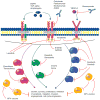Emerging drugs to treat squamous cell carcinomas of the head and neck
- PMID: 20557270
- PMCID: PMC3133968
- DOI: 10.1517/14728214.2010.497754
Emerging drugs to treat squamous cell carcinomas of the head and neck
Abstract
Importance of the field: Head and neck squamous cell carcinoma (HNSCC) is the eighth leading cause of cancer death worldwide. Despite advances in surgery and chemoradiation therapy, there has been little improvement in survival rates over the past 4 decades. Additionally, surgery and chemoradiotherapy have serious side effects. The development of agents with greater efficacy and tolerability is needed.
Areas covered in this review: EGFR is the only proven molecular target for HNSCC therapy. Cetuximab, the sole FDA-approved molecular targeted HNSCC therapy, and other potential targeted therapies are being evaluated in preclinical, clinical and post-marketing studies. Here, we review the emerging targets for biological agents in HNSCC and the rationale for their selection.
What the reader will gain: Key information in the development of new drug targets and the emergence of new biomarkers are discussed. Readers will gain insight regarding the limitations of current therapies, the impact of recently approved targeted therapies and the influence that predictive biomarkers will have on drug development.
Take home message: The head and neck cancer drug market is rapidly evolving. Coordination between drug and biomarker development efforts may soon yield targeted therapies that can achieve the promise of personalized cancer medicine.
Conflict of interest statement
Figures

Similar articles
-
Molecular targeted therapies in the management of head and neck squamous cell carcinoma: recent developments and perspectives.Anticancer Agents Med Chem. 2013 Mar;13(3):389-402. Anticancer Agents Med Chem. 2013. PMID: 23092267 Review.
-
Investigational EGFR-targeted therapy in head and neck squamous cell carcinoma.Expert Opin Investig Drugs. 2010 Jun;19(6):709-22. doi: 10.1517/13543781003769844. Expert Opin Investig Drugs. 2010. PMID: 20415598 Free PMC article. Review.
-
Preclinical modeling of EGFR inhibitor resistance in head and neck cancer.Cancer Biol Ther. 2012 Aug;13(10):935-45. doi: 10.4161/cbt.20846. Epub 2012 Aug 1. Cancer Biol Ther. 2012. PMID: 22785204 Free PMC article.
-
Molecular characterization of head and neck cancer: how close to personalized targeted therapy?Mol Diagn Ther. 2012 Aug 1;16(4):209-22. doi: 10.2165/11635330-000000000-00000. Mol Diagn Ther. 2012. PMID: 22873739 Free PMC article.
-
EGFR targeting drugs in the treatment of head and neck squamous cell carcinoma.Expert Opin Emerg Drugs. 2010 Jun;15(2):185-201. doi: 10.1517/14728211003716442. Expert Opin Emerg Drugs. 2010. PMID: 20415599 Review.
Cited by
-
The vascular disrupting agent ombrabulin (AVE8062) enhances the efficacy of standard therapies in head and neck squamous cell carcinoma xenograft models.Invest New Drugs. 2013 Apr;31(2):273-84. doi: 10.1007/s10637-012-9852-4. Epub 2012 Jul 19. Invest New Drugs. 2013. PMID: 22810221
-
Co-expression of perforin and granzyme B genes induces apoptosis and inhibits the tumorigenicity of laryngeal cancer cell line Hep-2.Int J Clin Exp Pathol. 2014 Feb 15;7(3):978-86. eCollection 2014. Int J Clin Exp Pathol. 2014. PMID: 24696715 Free PMC article.
-
Syngeneic animal models of tobacco-associated oral cancer reveal the activity of in situ anti-CTLA-4.Nat Commun. 2019 Dec 5;10(1):5546. doi: 10.1038/s41467-019-13471-0. Nat Commun. 2019. PMID: 31804466 Free PMC article.
-
Receptor, Signal, Nucleus, Action: Signals That Pass through Akt on the Road to Head and Neck Cancer Cell Migration.Cancers (Basel). 2022 May 25;14(11):2606. doi: 10.3390/cancers14112606. Cancers (Basel). 2022. PMID: 35681586 Free PMC article. Review.
-
Impact of human papillomavirus on oropharyngeal cancer biology and response to therapy: implications for treatment.Otolaryngol Clin North Am. 2013 Aug;46(4):521-43. doi: 10.1016/j.otc.2013.04.009. Epub 2013 Jun 27. Otolaryngol Clin North Am. 2013. PMID: 23910468 Free PMC article. Review.
References
-
- Horner M, Ries L, Krapcho M, et al. SEER Cancer Statistics Review, 1975-2006. [31 March 2010];2009 Available from: http://seercancergov/csr/1975_2006/
-
- Parkin DM, Bray F, Ferlay J, Pisani P. Global cancer statistics, 2002. CA Cancer J Clin. 2005;55(2):74–108. - PubMed
-
- Kamangar F, Dores GM, Anderson WF. Patterns of cancer incidence, mortality, and prevalence across five continents: defining priorities to reduce cancer disparities in different geographic regions of the world. J Clin Oncol. 2006;24(14):2137–50. - PubMed
-
- Boyle P, Levin B, editors. World Cancer Report 2008. WHO Press; Lyon: 2008.
-
- Curado MP, Hashibe M. Recent changes in the epidemiology of head and neck cancer. Curr Opin Oncol. 2009;21(3):194–200. - PubMed
Publication types
MeSH terms
Substances
Grants and funding
LinkOut - more resources
Full Text Sources
Other Literature Sources
Medical
Research Materials
Miscellaneous
